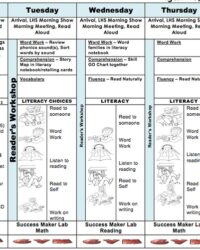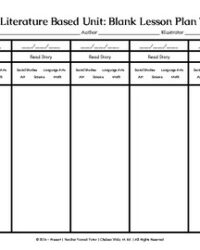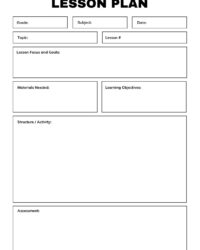Ever feel like you are juggling a dozen balls at once in the classroom, trying to keep every student engaged, ensure they are learning, and manage your time effectively? You are not alone! Teaching is an art, but it also benefits immensely from a solid structure. That is where a well-thought-out lesson plan comes into play, providing a roadmap for both you and your students.
Imagine walking into your teaching space feeling confident, knowing exactly what you will achieve, how you will achieve it, and how you will measure success. That peace of mind is incredibly valuable. While there are many planning frameworks out there, one particularly effective and widely recognized approach is the five step lesson plan template, often referred to as the 5E Model. This model provides a natural, logical flow for learning that promotes deeper understanding and greater student engagement.
Unlocking the Power of the 5E Lesson Plan Model
The 5E Model is more than just a sequence of steps; it is a philosophy for learning that guides students through an experience where they actively construct their own understanding of concepts. This approach moves away from traditional lecture-based teaching towards a more student-centered, inquiry-based method. It encourages critical thinking, problem-solving, and collaboration, making lessons dynamic and memorable. Let us break down each of these essential phases to see how they build upon one another to create a powerful learning journey.
Engage: Sparking Curiosity
The first E, Engage, is all about grabbing your students’ attention and connecting the new lesson to their prior knowledge or experiences. This phase should be short, sharp, and designed to pique their curiosity. You want them to feel intrigued and ready to dive into the topic. Think of it as setting the hook for the entire lesson. It could involve a thought-provoking question, a short video clip, a surprising demonstration, a quick brainstorming activity, or even a real-world problem they need to consider. The goal is to make them wonder and want to learn more.
Explore: Hands-On Discovery
Once engaged, students move into the Explore phase, which is truly the heart of the 5E Model. Here, students get hands-on experience with the concepts. They are encouraged to investigate, experiment, observe, and gather data. The teacher acts as a facilitator, providing necessary materials and guidance, but largely allowing students to work collaboratively to discover answers and new questions. This might involve conducting an experiment, reading and analyzing texts, participating in a simulation, or solving a problem using various resources. The idea is for them to build their own understanding through direct experience before formal explanations are introduced.
Explain: Building Understanding
After their exploration, students transition into the Explain phase. This is where you, as the teacher, help them make sense of their discoveries and formalize their understanding. This is not just a lecture; it is a guided discussion where students share their findings, pose questions, and clarify concepts. You introduce new vocabulary, definitions, and explanations as needed, linking them directly to the students’ exploration activities. It is a collaborative process where the teacher fills in gaps, corrects misconceptions, and provides the scientific or academic language for what students have already begun to understand intuitively.
Elaborate: Deepening Connections
The Elaborate phase is all about applying and extending the knowledge students have gained. Here, students are challenged to take their new understanding and use it in different contexts, solve more complex problems, or connect it to other areas of study. This phase encourages higher-order thinking and helps solidify learning by making it relevant to broader situations. It might involve designing a new experiment, creating a presentation, debating a related issue, or applying a concept to a real-world scenario. The goal is to demonstrate a deeper, more flexible understanding of the topic.
Evaluate: Checking for Mastery
Finally, the Evaluate phase allows both you and your students to assess their understanding and mastery of the concepts. This can happen throughout the lesson through informal observation and questioning, but it culminates in a more formal assessment in this phase. Evaluation should not just be about testing; it should also provide an opportunity for students to reflect on their learning and for you to gauge the effectiveness of your instruction. This could be through traditional quizzes, projects, presentations, portfolios, or even self-assessments and peer reviews. The key is to gather evidence of learning and identify any areas that might need further attention.
Tips for Implementing Your Five Step Lesson Plan
Successfully using a five step lesson plan template requires more than just following steps; it demands thoughtful planning and flexibility. While the 5E Model provides an excellent structure, remember that every group of students is unique, and sometimes you will need to adjust the timing or specific activities to best meet their needs. The beauty of this framework lies in its adaptability, allowing you to tailor lessons to diverse learners and subjects, from science experiments to historical analyses.
One of the most crucial aspects of planning effectively within this framework is setting clear, measurable learning objectives from the outset. Before you even think about the “Engage” activity, ask yourself: What specifically do I want my students to know, understand, or be able to do by the end of this lesson? Having clear objectives will guide your choice of activities for each of the five Es, ensuring that every part of your lesson contributes meaningfully to student learning. Without a clear destination, it is hard to plot a course.
Consider these practical tips to enhance your planning and delivery:
- Allocate appropriate time for each phase, recognizing that the Explore and Elaborate phases often require more time for student work.
- Ensure smooth transitions between phases, making it clear to students what they are doing and why.
- Prepare all materials in advance, especially for the Explore phase, to minimize disruption and maximize student engagement.
- Think about differentiation strategies for each phase to support all learners, whether they need extra help or more challenging opportunities.
- Incorporate formative assessment throughout the lesson, not just in the Evaluate phase, to continuously monitor understanding.
By keeping these points in mind, your five step lesson plan will not just be a theoretical document but a dynamic guide that helps create truly impactful learning experiences for everyone in your classroom. It is a powerful tool for promoting deep learning and making your teaching journey more organized and rewarding.
Adopting a structured approach to lesson planning, such as the 5E Model, can truly transform your teaching practice. It provides a consistent yet flexible framework that empowers students to take ownership of their learning, fostering curiosity, critical thinking, and a deeper understanding of concepts. When students are actively involved in discovering and making sense of information, the learning sticks, and their enthusiasm for the subject grows naturally.
Embracing a comprehensive planning strategy ultimately leads to more confident teaching and more engaged, successful learners. By thoughtfully guiding students through the interconnected phases of engagement, exploration, explanation, elaboration, and evaluation, you are not just delivering content; you are cultivating a lasting love for learning and equipping them with the skills they need to thrive. Start applying these principles, and watch your classroom become a vibrant hub of discovery.


